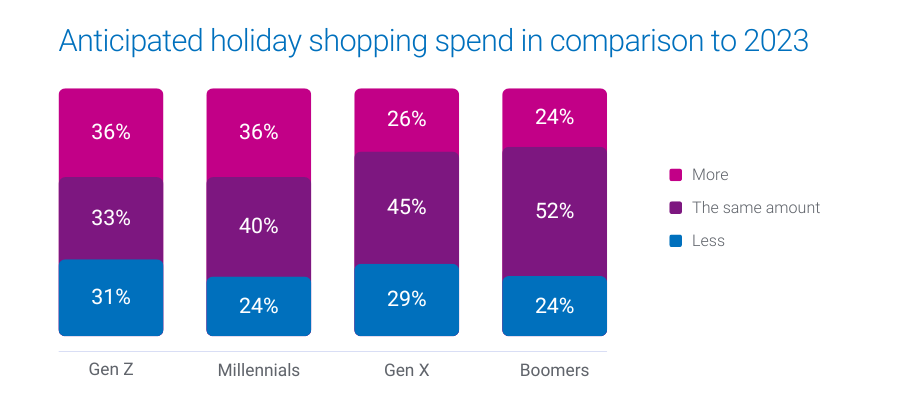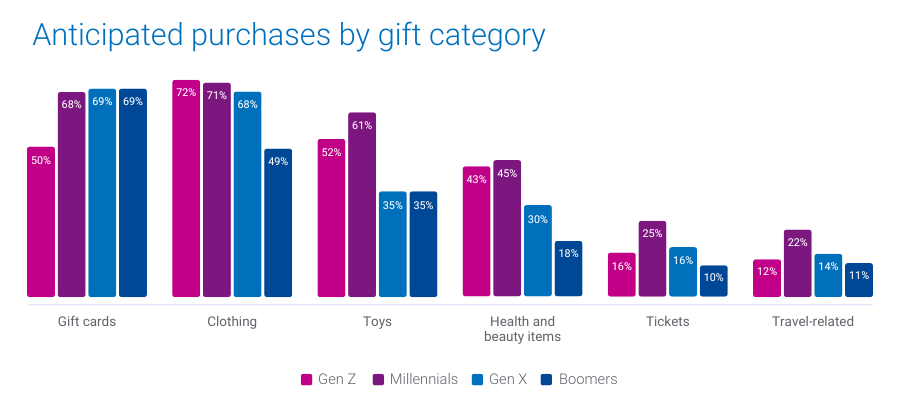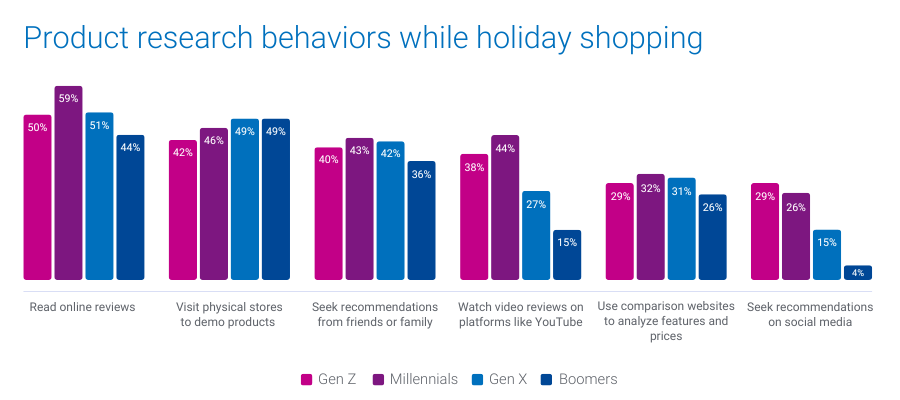
The holiday season is almost here, and knowing how each generation plans to shop can give your holiday advertising campaigns the edge you need. Our recent survey of 1,000 U.S. consumers reveals 2024 holiday shopping trends for each generation and key insights into their anticipated spending levels, preferred shopping categories, and how they look for gift ideas.
In this blog post, we’ll explore three 2024 holiday shopping trends across generations:
- Projected consumer spending
- Top categories on shoppers’ lists
- Preferred channels for researching gifts
1. Projected consumer spending
Over 1 in 3 Gen Z and Millennials are gearing up to increase their holiday budgets this year, while Gen X and Boomers are likelier to stick to last year’s budget.
- 36% of Millennials and Gen Z plan to spend more this holiday season
- 45% of Gen X and 52% of Boomers expect their spending to remain consistent with last year

What this means for marketers
These insights highlight the importance of tailoring your messaging. For Gen Z and Millennials, emphasize value and unique offerings that justify increased spending. For Gen X and Boomers, focus on trust and reliability, reinforcing their confidence in your brand.
How Experian can help you target these audiences
Experian’s custom and syndicated audience segments, including Holiday Shopper High Spenders and Holiday Shopper Moderate Spenders, enable you to connect with these diverse consumer groups. Our audiences are available on-the-shelf of leading ad platforms to help you reach people across social, TV, and mobile.
The election effect
U.S. holiday retail sales saw 4.1% YoY growth in 2016 and 8.3% YoY growth in 2020 following presidential elections. There’s a chance that holiday spending increases after the 2024 election, regardless of the outcome. Experian has 240+ politically relevant audiences that you can activate across major ad platforms ahead of the upcoming election.
2. Top categories on shoppers’ lists
Different generations have distinct preferences when it comes to what they plan to buy. Gift cards top the list for Gen X and Boomers, while Gen Z leans toward clothing. Millennials are looking to splurge on toys, electronics, and experiences.
- 69% of Boomers and Gen X plan to purchase gift cards
- 72% of Gen Z will buy clothing
- 45% of Millennials will buy health and beauty items
- 25% of Millennials will buy tickets and 22% of Millennials will buy experiences

What this means for marketers
Align your product offerings and promotions with each generation’s preferences to capture their attention. For example, highlighting versatile gift cards may resonate more with older generations, while showcasing trendy apparel and tech gadgets will appeal to younger consumers.
How Experian can help you target these shoppers
We offer audience segments like Holiday Shoppers: Apparel, Cosmetics & Beauty Spenders, and Toys Shoppers that you can activate to connect with consumers primed to purchase in these categories.
We recently released 19 new holiday shopping audiences we recommend targeting to drive engagement and conversions. Download our audience recommendations here.
3. Preferred channels for researching gift ideas
When it comes to finding the perfect gifts, Gen Z turns to social media, while Millennials prefer online reviews and video content. Boomers and Gen X are more inclined to visit physical stores for hands-on product evaluations.
- 29% of Gen Z and 26% of Millennials will look for gift ideas on social media
- 44% of Millennials will rely on video reviews and product demos on platforms like YouTube
- 49% of Gen X and Boomers plan to visit physical stores to evaluate products in person

What this means for marketers
Understanding where each generation looks for inspiration can guide your content and ad placement strategy. To engage Gen Z, focus on social media campaigns and influencer partnerships. For Millennials, consider investing in video content and reviews. For older generations, ensure your in-store experience is optimized to convert browsing into purchases.
How Experian can help you engage these shoppers
Our TrueTouchTM audiences can help you pair the perfect messaging styles with the right channels and calls to action. Our Social media channel and content engagement audiences can help you reach Gen Z who are likely to be active users on major social platforms and are Black Friday shoppers. For a full list of Experian’s syndicated audiences and activation destinations, download our syndicated audiences guide.
Download our report for five 2024 holiday shopping trends by generation
Understanding 2024 holiday shopping trends by generation can help you tailor your targeting, messaging, media planning, and creative based on the generation you’re targeting.
In addition to the insights covered here, download our 2024 Holiday spending trends and insights report to learn:
- When consumers plan to shop (hint: they’re already shopping)
- Where they plan to shop (online vs. in-store)
Download our full report to access all five of our predictions by generation, so you can address the diverse needs of this year’s holiday shoppers.
When you work with Experian for your holiday shopping campaigns, you’re getting:
- Accurate consumer insights: Better understand your customers’ behavioral and demographic attributes with our #1 ranked data covering the full U.S. population.
- Signal-agnostic identity solutions: Our deep understanding of people in the offline and digital worlds provides you with a persistent linkage of personally identifiable information (PII) data and digital IDs, ensuring you accurate cross-device targeting, addressability and measurement.
- Secure connectivity: Bring data and identity to life in a way that meets your needs by securely sharing data between partners, utilizing the integrations we have across the ecosystem, and using our marketing data in flexible ways.
Make the most of this holiday shopping season with Experian. Contact us today to get started.
Source
Online survey conducted in June, 2024 among n=1,000 U.S. adults 18+. Sample balanced to look like the general population on key demographics (age, gender, household income, ethnicity, and region).
Latest posts

Partnership Yields Increased Match and Connectivity Rate Through Tapad Graph, acquired by Experian March 27, 2018 — New York, N.Y. — Tapad, part of Experian, is reinventing personalization for the modern marketer and today announced the impactful results of its strategic partnership with Flashtalking, the leading global independent platform for ad delivery, unification and insights. Flashtalking is one of Tapad's most engaged partners, using the Tapad Graph to unify cross-device engagement and identity-driven consumer behaviors for attribution modeling. The company leverages a unique identifier that, in conjunction with Tapad's Graph, provides robust multi-touch attribution solution for its clients. This partnership has resulted in above-industry match and bridge rates for Flashtalking and its customers. Overall, the Tapad Graph yielded a 71 percent match rate with 41 percent of converters engaging on multiple devices, highlighting the importance of cross-device measurement. Tapad’s identity solutions provide Flashtalking with a more holistic view of global engagement. Flashtalking marries ad server log file data with the Tapad Graph to connect all interactions in the consumer journey. This enables Flashtalking to provide more accurate and impactful cross-device attribution, which ultimately enables better optimization. These achievements have led to recognition of Tapad and Flashtalking’s work by the I-COM Global Forum for Marketing, Data and Measurement. “Tapad allows us to understand user engagement across devices and platforms at both the household or individual user level, which is extremely beneficial when providing marketers with true path to conversion and attribution,” said Steve Latham, global head of analytics at Flashtalking. “Since our relationship began, we’ve successfully leveraged Tapad data to provide more accurate, actionable insights that have helped numerous brands achieve substantial gains in media effectiveness.” Flashtalking client Michael Lamontagne, SVP of analytics and CRM at 22squared says “We are big believers in using cross-device insights to improve our campaigns. Flashtalking has been a strategic partner in the pursuit of that goal. By incorporating the Tapad Graph, Flashtalking delivers powerful insights into user engagement and media attribution across browsers and devices. Of equal importance, their bundled solution makes it easy and efficient, saving our team countless hours of busy work.” “Our ongoing work with Flashtalking has had a significant impact on the accomplishments we’ve achieved,” said Chris Feo, SVP, strategy & global partnerships at Tapad. “Being able to grow with a dedicated partner that leverages our proprietary technology in unique ways has helped us uncover the global impact our services can have on a business. We’re proud to drive success for Flashtalking’s clients on a global scale.” Contact us today

Digital Marketing Challenges Are you new to digital marketing? If you answered yes, then you may already know this is a complex world made up of cookies, pixels, attribution, and unique KPIs. With nearly 10 years of advertising experience, Experian is familiar with the challenges advertisers face as they prepare for their first digital marketing campaign. Those challenges include: determining a target audience, justifying data fees for targeting, sending a consistent message to every channel and measuring the success of a campaign. Of these challenges, creating an accurate, data-driven target audience and understanding the attribution process are the two most common. Coincidentally, these two challenges tend to be the most difficult to overcome and have the highest impact on a campaign’s success. 1.) Creating an accurate, data-driven target audience Understanding the basic demographics of your customer is the first step in the audience creation process. Your next step should be to understand your customers’ lifestyles, purchase behaviors, and current interests. By truly knowing your customer, you are then able to build out a multi-channel targeting strategy comprehensive of not only basic demographics and past behavioral data, but current behavioral trends that lead to individuals who are in market for a product or service. This reduces irrelevant marketing to individuals who may have the demographic characteristics, but are not yet in market. Overall, creating a relevant target audience saves media spend by focusing on targeting tactics that have a higher potential for success. 2.) Understanding the attribution process Now that you have your target audience, you need to determine how to measure the success of your campaign. Is your goal to increase online purchases? Drive store visits? Or, do you want your overall revenue to grow by a certain amount? Before launching your campaign, make sure you have a clear goal as well as a plan for measuring whether or not you meet your goal. Most digital marketers will judge the success of a campaign by online events, such as site visits, form completions, or online purchases. However, you may also want to measure offline metrics like phone calls or in person visits to a brick and mortar store. Offline metrics are essential to campaign performance, but are frequently over looked. Experian’s OmniActivation Strategic Services recommends having one clear goal that can be accurately measured. This ensures your campaign’s target audience and optimizations support the metric that will ultimately determine the success of your campaign.

Every day it seems, mobile device fragmentation increases. With consumers spending their time online across multiple devices – phones, tablets, over-the-top TV devices, gaming consoles, a nascent, yet growing internet-of-things, and a variety of other internet connected devices – the challenge of keeping up with consumers continues to be a daunting one. The industry has, of course, adopted many different identity solutions and cross-device technologies. Perhaps you’ve adopted some of them. Perhaps you feel like they are working. But perhaps you feel you could be doing a better job at connecting the dots. Marketers require solutions that can truly unify identities across channels and devices in order to understand consumer behavior, predict intent, and ultimately reach them with relevant communications. The easier it is to do that, the better. So, consider a couple scenarios and see how well are you doing. Within your core CRM data, are you able to connect your email subscribers to your in-store customers, all without relying on a loyalty program? Can you do this all the way down to an individual level? And are you leveraging this connected identity information to inform future online targeting? This kind of PII-based identity management is foundational to consumer engagement! Next scenario. Are you an app publisher? Or a media platform? Or any other type of organization that has a steady stream of device data? How much do you know about the consumer behind the device? Behavioral information is certainly a step in the right direction. But what about known consumer insights? How deep is the profile of information you’ve built for each device? Does it include both online and offline insights? Done in a compliant manner? There are a myriad of different techniques and approaches available to you to keep up with consumers. If you’re considering implementing a new strategy in the near future, or have questions about your current ones, contact Experian and we can help assess the opportunities available to you.